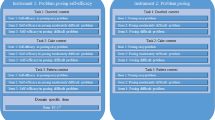Abstract
Posing modelling problems in class is supposed to increase students’ motivation. As motivation is assumed to emerge from task value and self-efficacy expectations, the present study considered both constructs with the aims to examine (1) whether students have different values and self-efficacy expectations concerning modelling problems versus dressed up word problems and intra-mathematical problems and (2) whether mathematical content influences task value and self-efficacy concerning different types of problems. We asked 90 high- and middle-track students (ninth- and tenth-graders) how much they valued modelling problems, dressed up word problems, and intra-mathematical problems and if they were confident they could solve these types of problems. All of the problems that we used could be solved by applying mathematical procedures from two different mathematical content areas (Pythagorean theorem or linear functions). The results indicated that there were significant differences in students’ task values and self-efficacy depending on the type of problem. Students reported the lowest task values and self-efficacy expectations for modelling problems compared with the other types of problems. Moreover, the differences between students’ task values (but not between students’ self-efficacy expectations) within the three types of problems seemed to depend on the mathematical content area. Intra-mathematical problems that could be solved by applying the Pythagorean theorem were valued higher than problems involving linear functions, whereas for modelling and dressed up word problems, it was the other way around. Implications for future research and classroom practice are discussed.





Similar content being viewed by others
References
Bandura, A. (1977). Self-efficacy: Toward a unifying theory of behavioral change. Psychological Review, 191–215.
Bandura, A. (1997). Self-efficacy: The exercise of control. New York, NY: Freeman.
Berger, J.-L., & Karabenick, S. A. (2011). Motivation and students’ use of learning strategies: Evidence of unidirectional effects in mathematics classrooms. Learning and Instruction, 21(3), 416–428.
Blum, W. (2011). Can modelling be taught and learnt? Some answers from empirical research. In G. Kaiser, W. Blum, R. Borromeo Ferri & G. Stillman (Eds.), Trends in teaching and learning of mathematical modelling: ICTMA14 (pp. 15–30). Dordrecht: Springer.
Blum, W., & Ferri, R. B. (2009). Mathematical modelling: Can it be taught and learnt? Journal of Mathematical Modelling and Application, 1(1), 45–58.
Blum, W., & Leiß, D. (2007). How do students and teachers deal with mathematical modeling problems? The example of Sugerloaf. In C. Haines, P. Galbraith, W. Blum & S. Khan (Eds.), Mathematical modelling: education, engineering and economics—ICTMA12 (pp. 222–231). Chichester: Horwood.
Blum, W., & Niss, M. (1991). Applied mathematical problem solving, modelling, applications, and links to other subjects-state, trends and issues in mathematics instruction. Educational Studies in Mathematics, 22, 37–68.
Bong, M. (1997). Generality of academic self-efficacy judgments: Evidence of hierarchical relations. Journal of Educational Psychology, 89(4), 696–709.
Bong, M. (2001). Role of self-efficacy and task-value in predicting college students’ course performance and future enrollment intentions. Contemporary Educational Psychology, 26(4), 553–570.
Brown, J. S., Collins, A., & Duguid, P. (1989). Situated cognition and the culture of learning. Educational Researcher, 18(1), 32–42.
Butz, A. R., & Usher, E. L. (2015). Salient sources of early adolescents’ self-efficacy in two domains. Contemporary Educational Psychology, 42, 49–61.
Cooper, B., & Dunne, M. (2000). Assessing children’s mathematical knowledge: social class, sex, and problem-solving. Buckingham: Open University Press.
Eccles, J. S., Adler, T. F., Futterman, R., Goff, S. B., Kaczala, C. M., & Meece, J. L., et al. (1983). Expectancies, values, and academic behaviors. In J. T. Spence (Ed.), Achievement and achievement motivation (pp. 75–146). San Francisco, CA: Freeman.
Eccles, J. S., & Wigfield, A. (1995). In the mind of the actor: The structure of adolescents’ achievement task values and expectancy-related beliefs. Personality and social psychology bulletin, 21(3), 215–225.
Eccles, J. S., & Wigfield, A. (2002). Motivational beliefs, values, and goals. Annual Review of Psychology, 53(1), 109–132.
Eccles, J. S., Wigfield, A., & Schiefele, U. (1998). Motivation to succeed. In W. Damon (Series Ed.) and N. Eisenberg (Vol, Ed.) Handbook of child psychology: Social, emotional, and personality development (Vol. 3, 5th ed, pp. 1017–1095). Hoboken, NJ: Wiley.
Galbraith, P. L., & Stillman, G. (2001). Assumptions and context: Pursuing their role in modelling activity. In J. Matos, W. Blum, K. Houston & S. Carreira (Eds.), Modelling and mathematics education: ICTMA 9: Applications in Science and Technology (pp. 300–310). Chicester: Horwood.
Galbraith, P. L., & Stillman, G. (2006). A framework for identifying student blockages during transitions in the modelling process. ZDM, 38(2), 143–162.
Greer, B., Verschaffel, L., Van Dooren, W., & Mukhopadhyay, S. (2009). Making sense of word problems: Past, present, and future. In L. Verschaffel, B. Greer, W. Van Dooren & S. Mukhopadhyay (Eds.), Words and worlds modelling verbal descriptions of situations (pp. xi–xxviii). Rotterdam: Sense Publishers.
Harks, B., Klieme, E., Hartig, J., & Leiss, D. (2014). Separating cognitive and content domains in mathematical competence. Educational Assessment, 19(4), 243–266.
Hulleman, C. S., Durik, A. M., Schweigert, S., & Harackiewicz, J. M. (2008). Task values, achievement goals, and interest: An Integrative analysis. Journal of Educational Psychology, 100(2), 398–416.
Jordan, A., Krauss, S., Löwen, K., Blum, W., Neubrand, M., & Brunner, M., et al. (2008). Aufgaben im COACTIV-Projekt: Zeugnisse des kognitiven Aktivierungspotentials im deutschen Mathematikunterricht [Tasks in the COACTIV project: evidence of the potential for cognitive activation in German mathematics instruction]. Journal für Mathematikdidaktik, 29(2), 83–107.
Kaiser, G. (1985). Realitätsbezüge im Mathematikunterricht—Ein Überblicküber die aktuelle und historische Diskussion [Connections to reality in mathematics class—Survey of actual and historical discussion]. In G. Graumann, T. Jahnke, G. Kaiser & J. Meyer (Eds.), Materialien für einen realitätsbezogenen Mathematikunterricht (Vol. 2, pp. 66–84). Hildesheim: Franzbecker.
Kaiser, G., & Sriraman, B. (2006). A global survey of international perspectives on modelling in mathematics education. ZDM, 38(3), 302–310.
Klieme, E., Bürgermeister, A., Harks, B., Blum, W., Leiß, D., & Rakoczy, K. (2010). Leistungsbeurteilung und Kompetenzmodellierung im Mathematikunterricht [Performance assessment and competence modelling in mathematics instruction]. In E. Klieme, D. Leutner & M. Kenk (Eds.), Kompetenzmodellierung. Zwischenbilanz des DFG-Schwerpunktprogramms und Perspektiven des Forschungsansatzes (pp. 64–74). Weinheim: Beltz.
Krawitz, J., Schukajlow, S., & Van Dooren, W. (2016). Effects of short-term practicing on realisitic responses to missing data problems. In C. Csíkos, A. Rausch, & J. Szitányi (Eds.), Proceedings of the 40th Conference of the International Group for the Psychology of Mathematics Education (Vol. 3, pp. 131–138). Szeged, Hungary: PME.
Krug, A., & Schukajlow, S. (2013). Problems with and without connection to reality and students’ task-specific interest. In A. M. Lindmeier, & A. Heinze (Eds.), Proceedings of the 37th Conference of the International Group for the Psychology of Mathematics Education (Vol. 3, pp. 209–216). Kiel, Germany: PME.
Kultusministerkonferenz, (KMK). (2004). Bildungsstandards im Fach Mathematik für den mittleren Schulabschluss [Intermediate-level education standards for mathematics]. Munich: Wolters Kluwer.
Lopez, F., Lent, R., Brown, S. D., & Gore, P. A. (1997). Role of social–cognitive expectations in high school students’ mathematics-related interest and performance. Journal of Counseling Psychology, 44(1), 44–52.
Maaß, K. (2010). Classification scheme for modelling tasks. Journal für Mathematikdidaktik, 31(2), 285–311.
Mac Iver, D. J., Stipek, D. J., & Daniels, D. H. (1991). Explaining within-semester changes in student effort in junior high school and senior high school courses. Journal of Educational Psychology, 83(2), 201–211.
Meece, J. L., Wigfield, A., & Eccles, J. S. (1990). Predictors of math anxiety and its influence on young adolescents’ course enrollment intentions and performance in mathematics. Journal of Educational Psychology, 82(1), 60–70.
Middleton, J. A., & Spanias, P. A. (1999). Motivation for achievement in mathematics: Findings, generalizations, and criticisms of the research. Journal for Research in Mathematics Education, 30(1), 65–88.
Multon, K. D., Brown, S. D., & Lent, R. W. (1991). Relation of self-efficacy beliefs to academic outcomes: a meta-analytic investigation. Journal of Counseling Psychology, 38(1), 30–38.
National Council of Teachers of Mathematics. (2000). Principles and standards for school mathematics. Reston, VA: National Council of Teachers of Mathematics.
Niss, M. (2015). Mathematical competencies and PISA. In K. Stacey & R. Turner (Eds.), Assessing mathematical literacy: The PISA experience (pp. 35–55). Heidelberg: Springer.
Niss, M., Blum, W., & Galbraith, P. L. (2007). Introduction. In W. Blum, P. L. Galbraith, H.-W. Henn & M. Niss (Eds.), Modelling and applications in mathematics education: the 14th ICMI Study (pp. 1–32). New York: Springer.
OECD. (2003). The PISA 2003 assessment framework: Mathematics, reading, science and problem solving knowledge and skills. Paris: OECD Publishing.
Pajares, F., & Miller, M. D. (1994). Role of self-efficacy and self-concept beliefs in mathematical problem solving: A path analysis. Journal of Educational Psychology, 86(2).
Pajares, F., & Miller, M. D. (1995). Mathematics self-efficacy and mathematics performances: The need for specificity of assessment. Journal of Counseling Psychology, 42(2), 190–198.
Palm, T. (2008). Impact of authenticity on sense making in word problem solving. Educational Studies in Mathematics, 67(1), 37–58.
Pekrun, R. (2006). The control-value theory of achievement emotions: Assumptions, corollaries, and implications for educational research and practice. Educational Psychology Review, 18(4), 315–341.
Pietsch, J., Walker, R., & Chapman, E. (2003). The relationship among self-concept, self-efficacy, and performance in mathematics during secondary school. Journal of Educational Psychology, 95(3), 589–603.
Pintrich, P. R. (1999). The role of motivation in promoting and sustaining self-regulated learning. International Journal of Educational Research, 31, 459–470.
Pintrich, P. R., & de Groot, E. V. (1990). Motivational and self-regulated learning components of classroom academic performance. Journal of Educational Psychology, 82(1), 33–40.
Schukajlow, S., Kolter, J., & Blum, W. (2015a). Scaffolding mathematical modelling with a solution plan. ZDM, 47(7), 1241–1254.
Schukajlow, S., & Krug, A. (2014). Do multiple solutions matter? Prompting multiple solutions, interest, competence, and autonomy. Journal for Research in Mathematics Education, 45(4), 497–533.
Schukajlow, S., Krug, A., & Rakoczy, K. (2015b). Effects of prompting multiple solutions for modelling problems on students’ performance. Educational Studies in Mathematics, 89(3), 393–417.
Schukajlow, S., & Leiss, D. (2011). Selbstberichtete Strategienutzung und mathematische Modellierungskompetenz [Self-reported use of strategies and mathematical modelling]. Journal für Mathematikdidaktik, 32(1), 53–77.
Schukajlow, S., Leiss, D., Pekrun, R., Blum, W., Müller, M., & Messner, R. (2012). Teaching methods for modelling problems and students’ task-specific enjoyment, value, interest and self-efficacy expectations. Educational Studies in Mathematics, 79(2), 215–237.
Schukajlow, S., & Rakoczy, K. (2016). The power of emotions: Can enjoyment and boredom explain the impact of individual preconditions and teaching methods on interest and performance in mathematics? Learning and Instruction, 44, 117–127.
Usher, E. L., & Pajares, F. (2009). Sources of self-efficacy in mathematics: A validation study. Contemporary Educational Psychology, 34(1), 89–101.
Verschaffel, L., & Greer, B. (Eds.) (2000). Making sense of word problems (Contexts of Learning). Lisse, The Netherlands: Swets & Zeitlinger
Wigfield, A., & Eccles, J. S. (2000). Expectancy–value theory of achievement motivation. Contemporary Educational Psychology, 25(1), 68–81.
Zhu, Y., & Fan, L. (2006). Focus on the representation of problem types in intended curriculum: A comparison of selected mathematics textbooks from Mainland China and the United States. International Journal of Science and Mathematics Education, 4(4), 609–626.
Zimmerman, B. J., & Martinez-Pons, M. (1990). Student differences in self-regulated learning: Relating grade, sex, and giftedness to self-efficacy and strategy use. Journal of Educational Psychology, 82(1), 51–59.
Author information
Authors and Affiliations
Corresponding author
Appendix
Appendix
Sample tasks involving the Pythagorean theorem as a representative of one mathematical content area (see Figs. 6, 7, 8).
Modelling problem for the mathematical content area represented by the Pythagorean theorem (Schukajlow and Leiss 2011)
Dressed up word problem for the mathematical content area represented by the Pythagorean theorem (Krug and Schukajlow 2013)
Intra-mathematical problem for the mathematical content area represented by the Pythagorean theorem (Krug and Schukajlow 2013)
Rights and permissions
About this article
Cite this article
Krawitz, J., Schukajlow, S. Do students value modelling problems, and are they confident they can solve such problems? Value and self-efficacy for modelling, word, and intra-mathematical problems. ZDM Mathematics Education 50, 143–157 (2018). https://doi.org/10.1007/s11858-017-0893-1
Accepted:
Published:
Issue Date:
DOI: https://doi.org/10.1007/s11858-017-0893-1







